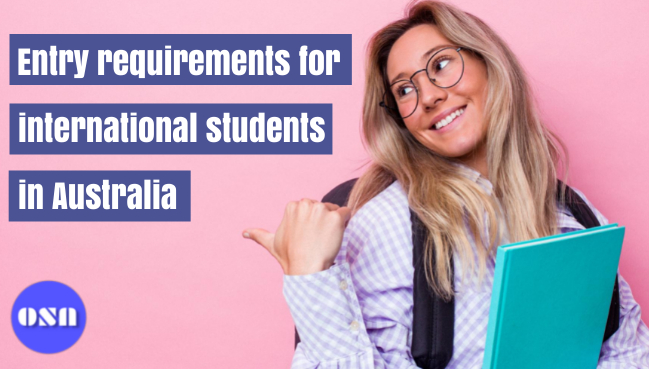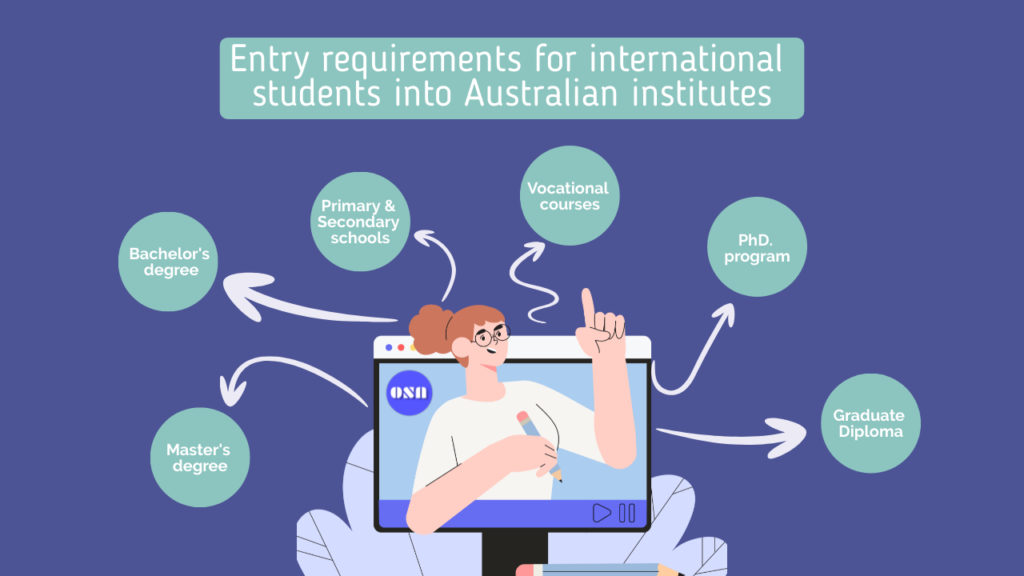Essential Entry Requirements for International Students for Admission to Australian Universities and Colleges

Students looking at their options for higher education abroad should give serious thought to Australian colleges and universities. It’s hardly surprising since the country has a top-notch educational system and awards degrees that are respected internationally.
When academic quality is top-notch, it is not easy to get admission to one of these institutions.
To begin with the process, you need to check if you already have the credentials required to continue your studies in Australia.
In general, institutions set out the academic criteria and English proficiency standards.
The English language requirements are tailored to non-native speakers, given that all courses and other kinds of communication are taught in English at Australian institutions.
Apart from that, there are requirements for things like visas and medical insurance.
The minimum required level of English proficiency and academic achievement level vary from institution to institution and degree to degree.
In this article, we will discuss the basic entry requirements for international students enrolling in Australian schools, colleges, and universities.
A brief guide for applying for admission into Australian educational institutes
You may start the application process after you’ve chosen a program and an institution.
Before submitting an application, prospective students should verify that they meet the minimum educational and English proficiency standards.
The majority of Australian overseas students apply directly by mail or online or through an educational agent. The application form will include the course(s) you want to enroll in, as well as provide required information and documentations.
The basic information required in most of the application forms are:
- Your personal information;
- Verified proof of English language proficiency;
- Transcripts of past academic qualifications
- References.
Many schools need a non-refundable application fee, often between $50 and $100 Australian Dollars (AUD), to be sent with the application.
Make sure you meet the criteria for a student visa on the Department of Home Affairs website before submitting an application.
Once you’ve submitted your application, the educational institution will examine it. It can take a few weeks before your application is processed (or longer for post graduate programs).
You will get an offer letter and an acceptance form if you are chosen. You should read the complete offer letter before making a choice in order to be well-informed about the conditions.
You must first fulfill the conditions in the offer letter in order to get a Confirmation of Enrollment from the institution (CoE).
After being approved and receiving the CoE from your educational institution, the next step is to apply for a student visa. Use your letter of offer or your CoE to apply for a student visa.
You will also be required to submit a GTE statement and get OSHC cover for your studies in Australia.
Now let’s look into more specific entry requirements into different courses in Australia.

Entry Requirements to study in primary and secondary school in Australia
Each school might have different admission criteria but to give you a general idea, following are the entry requirements.
Students in Prep through Year 6 can enroll in the Primary School program by meeting the following criteria:
- The program must run for a minimum of six months.
- Students whose first language is not English must either participate in a Young Learners Program or present documentation of their proficiency in the language.
Whereas if we talk about secondary education in Australia, it is offered by government and non-government institutes. Depending on the state or region and the duration of elementary school, it is offered for five to six years.
In Australia, secondary education consists of two study levels and starts in years 6 or 7.
- Secondary school (lasts 3 to 4 years – Years 7 to 10 or 8 to 10)
- Senior secondary school (lasts for two years – Year 11 and Year 12)
The requirements for enrolling in secondary school in Australia vary from one state or territory to the next, as do the specific schools you want to attend.
The application procedure considers several elements, including your academic record, extracurricular activity, athletic abilities, and other factors.
Candidates from other countries will be judged on how well they meet the English language standards. The student may enroll in a high school preparatory course to improve their English proficiency if they do not already fulfill the standard. We have already covered a separate article on getting secondary education in Australia; check it out here.
English Requirements:
Year 7 & 8 = IELTS 4.0 – TOEFL = 31
Year 9 = IELTS 4.5 – TOEFL = 32
Year 10 = IELTS 5.0 – TOEFL = 35
Year 11 = IELTS 5.5 – TOEFL = 46
Year 12 = IELTS 6.0 – TOEFL = 60
If you are under the age of 18, you will also need to have welfare arrangements sorted before arriving in Australia for your studies.
Entry Requirements for VET (Vocational courses) in Australia
Instead of going to university, international students can choose to undertake vocational education programs. These vocational programs are offered by various Tafes and private institutions, which both public and private universities offer, providing real-world learning experiences.
These programs provide real world experiences to the students, which hence equip them with skills to start working as soon as they graduate.
In order to ensure quality education in these programs, Government agencies keep an eye on these education providers and audit them regularly for compliance purposes.
Typically, students will attend 15 to 20 hours of in-person training weekly.
When students graduate from VET institutions, their credentials are recognised in Australia and often in other nations worldwide
Some basic entry requirements for vocational programs are as follows:
- International students who want to enroll in the VET system must complete a level of study comparable to years 10, 11, and 12 in Australia. In your native country, you must have attended and graduated from at least the third year of high school.
- International students may need to pass an English exam to enroll in a vocational program.
- While some courses would need job experience, others could have prerequisite subjects.
- A portfolio might be required for admission to courses like painting and design.
For English Proficiency, you must provide proof that you are at least at the following levels of English proficiency:
- IELTS: You will need to score an overall of 5.5, no band less than 5.0
- TOEFL: You will need to score an overall of 55 with individual section scores no less than (Listening: 9, Speaking: 16, Reading: 10, Writing: 18)
- PTE: You will need to score an overall of 42-49 with no section score less than 40
- CAE: You will need to score an overall of 162 with no individual band less than 154
Entry Requirements for Graduate Diploma and Graduate Certificate in Australia
A Graduate Certificate program is a 6 months full time program (one semester) and usually includes 3 to 4 units of study. The typical length of study for a graduate diploma at a university is 12 months and usually includes 8 units of study (two semesters).
A Graduate Certificate and Graduate Diploma is the next step for students after finishing a Bachelor’s degree in Australia.
The entry requirements for Graduate Certificate is a Bachelor’s degree and for Graduate Diploma is a Bachelor’s degree along with Graduate Certificate.
Apart from that, international students are usually required to provide proficiency of their English levels by providing a result for one of the following:
- IELTS: You will need to score an overall of 6.5, no band less than 6.0
- TOEFL: You will need to score an overall of 79 with individual section scores no less than (Listening: 19, Speaking: 19, Reading: 18, Writing: 22)
- PTE: You will need to score an overall of 58-64 with no section score less than 50
- CAE: You will need to score an overall of 176 with no individual band less than 169
Entry Requirements for Bachelor’s degree in Australia
International students can only apply for a bachelor’s degree in Australia after twelve years of elementary and secondary school.
International students are suggested to apply for admission early, so they have plenty of time to get necessary visas and arrange travel arrangements.
Standard admission entry requirements for a Bachelor degree in Australia are as:
- Application fee: Most universities will require application fee of around $100 to $200 to apply for their courses
- Academic Transcripts: You will also need a score of between 60% and 70% on the Australian equivalent of the High School Leaving Exam (HSLE) to apply to a Bachelor degree program in Australia (12th grade).
- English Test Results: A good score on an internationally recognised English language test that proves you’re proficient enough to study in Australia.
- Others: Further requirements such as surveys, letters of recommendation, work experience, portfolio’s etc.
In regards to the English proficiency, as a general guide, you will be required to provide a proof of one of the following levels:
- IELTS: You will need to score an overall of 6.0, no band less than 6.0
- TOEFL: You will need to score an overall of 67 with individual section scores no less than (Listening: 12, Speaking: 18, Reading: 15, Writing: 21)
- PTE: You will need to score an overall of 50-57 with no section score less than 50
- CAE: You will need to score an overall of 169 with no individual band less than 169
Entry Requirements for Master’s Degree in Australia
For getting into Master’s degree in Australia, having an undergraduate degree is a must.
The typical cutoff for eligibility to apply for a Master’s degree at Australian universities and Institutions is 60% or GPA of 4.0. The Australian Bachelor (Ordinary) Degree equals a foreign undergraduate degree such as a B.Sc., B.Com., or B.A.
If you are planning to do a Masters degree by research, then you might be required to have an equivalent to the Australian Bachelor (Honors) Degree or previous research experience.
Some other requirements are as follows:
- Application Fee: You will expected to pay $100 to $200 as an application fee
- Academic Transcripts: You must present the results of your earlier academic life. At the time of admission, you must present your Secondary School Certificate (Year 10 transcripts), High School Certificate (Year 12 transcripts). In addition, you must submit the Transcript of Records, which lists all of the subjects you studied for your Bachelor’s and the marks and grades you earned in each of them.
- Entrance Exam Results: You may also submit your results from any university entrance exams you’ve taken as evidence if you have! Some university courses like MBA might need students to undergo an entrance exam like GMAT, GAMSAT, LSAT etc.
- English Test Results: A good enough score is required in an internationally recognised English proficiency test for an overseas student. Most universities in Australia accept the IELTS, PTE, or TOEFL examinations to measure your proficiency in English. A letter from your former university that confirms that you completed your undergraduate degree entirely in English and don’t need to take any additional exams may also be accepted by certain universities.
- Attending Interviews: Interviews could be conducted by some universities in order to check the communication skills, professionalism and reasons for those specific courses.
Here is a general guide for the English proficiency scores that you need to provide for your Master’s degree in Australia. Please note that these numbers can vary from one institution to the other :
- IELTS: You will need to score an overall of 6.5, no band less than 6.0
- TOEFL: You will need to score an overall of 79 with individual section scores no less than (Listening: 19, Speaking: 19, Reading: 18, Writing: 22)
- PTE: You will need to score an overall of 58-64 with no section score less than 50
- CAE: You will need to score an overall of 176 with no individual band less than 169
Entry Requirements to PhD (Professional Doctorate Degree) in Australia
Getting entry into PhD programs in Australia is different from getting entry into most other courses. Most of the PhD programs in Australia are research based.
Before you submit your formal application to the university, you will need to find a research supervisor. This will be someone who will be the lead researcher in your preferred institution and area of study.
Then you need to submit a brief research proposal to this prospective supervisor. If the supervisor accepts your research topic, then you will receive an expression of interest from this provisional supervisor.
From here, you can start a formal application to the university. But if the supervisor doesn’t accept or support the application, then you will need to find another supervisor.
Most universities will not accept the formal application from PhD students until they have a research supervisor.
Once you have expression of interest, then you will need to meet the following requirements. Please note that each university sets its own requirements and might require you to meet further requirements than listed below here:
- A Bachelor’s and a Master’s degree in the relevant field of study.
- Evidence of your prior research experience certified from your previous university or universities.
- Approved expression of interest for your research proposal from academic supervisor
- References from the academic or professional world
- Universities might require students to go through an interview for getting accepted into Doctorate degrees.
- Provide proof of your English proficiency by undertaking IELTS/PTE/TOEFL/CAE test.
You must provide proof that you are at least at the following levels of English proficiency:
- IELTS: You will need to score an overall of 6.5, no band less than 6.0
- TOEFL: You will need to score an overall of 79 with individual section scores no less than (Listening: 19, Speaking: 19, Reading: 18, Writing: 22)
- PTE: You will need to score an overall of 58-64 with no section score less than 50
- CAE: You will need to score an overall of 176 with no individual band less than 169
We hope we were able to give you a general idea of what it looks like to apply for an admission to different programs in Australia. You can also check out the following related articles that we covered regarding studying in Australia.
Best and Worst Intake for studying in Australia as an international student


